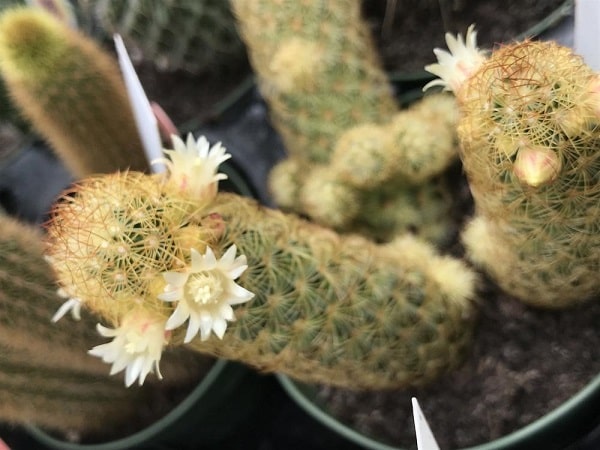Mammillaria Elongata or Lady Finger cactus is a species belonging to one of the largest genera of the Cactaceae family.
It is endemic to the State of Hidalgo, Guanajuato and the State of Querétaro in Mexico. And its natural habitat is desert areas.
Plant Characteristics
They are fast-growing and easy-growing plants that are usually used in pots given their small size although they are suitable for rockery and cactus and succulent gardens.
They are small cacti that form very branched groups of creeping bearing up to 15 cm in length.
Its body is rather cylindrical, of intense green color and is characterized by forming thin tubular stems of approximately 2.5 cm in diameter, which develop numerous lateral little children (these little ones develop a semi-erect or creeping growth), forming large colonies in A small area
The stems are formed by conical mammoths approximately 0.3 cm long; Round areolas have up to 28 star-curved radial spines and 0-3 central spines.
The flowers are white or yellowish, the petals have a medium reddish-brown line; each petal has a serrated margin and a rounded or sharp apex.
They arise with great profusion in the upper half of the stems.
They are small but much larger than the mammals (approximately 1.3 cm in diameter), appear at the base of these and open a few millimeters above the radial spines.
In the center of the flowers, there are numerous yellow stamens and a central multilobed stigma.
The floral opening is sometimes not complete due to the contact of the radial spines and the petals.
The flowers, which sprout in spring.
You may like: Crassula Tetragona
Tips to grow and care for the Lady Finger Cactus
Illumination
For your Mammillaria Elongata to grow perfectly, it is ideal to be in full sun.
It also grows in the middle shade and in hot and dry climates.
In very strong summers we can protect it from the midday sun although sunburn has rarely been recorded.
Substratum
Substrates for cacti and succulents can be used with the incorporation of a layer of gravel or coarse sand to further facilitate drainage.
It is a cactus very susceptible to root rot due to stagnation of water in the substrate.
That is why the substrate you use must have an excellent drainage system.
Temperatures
It requires developing in cool or warm climates where temperatures do not decrease from 3 ° C at any time of the year.
This species can survive short periods where temperatures are a little lower (always with the extremely dry substrate), but it is not recommended to take such a risk because it can rot.
The optimum range for the species is between 18-30 ° C.
Watering
They are very resistant to drought.
You may like how to water succulents
That is why you should water the plant when the substrate is completely dry at warm times of the year.
In winter seasons it is recommended to water once a week or biweekly to avoid rot.
Propagation
From the separation of grandfathers (they separate extremely easy).
We must let the wound dry for 24 hours and then sow on a sandy and slightly moist substrate, they will take root in approximately 7-10 days.
Plagues and diseases
It is not frequently attacked by pests being only its main enemy the excess moisture in the substrate.
Fertilizer
They thank a subscriber with a cactus fertilizer in spring and another in summer.
Just follow the fertilizer instructions you buy.
Prune
The elongata Mammillaria does not need to be pruned.
